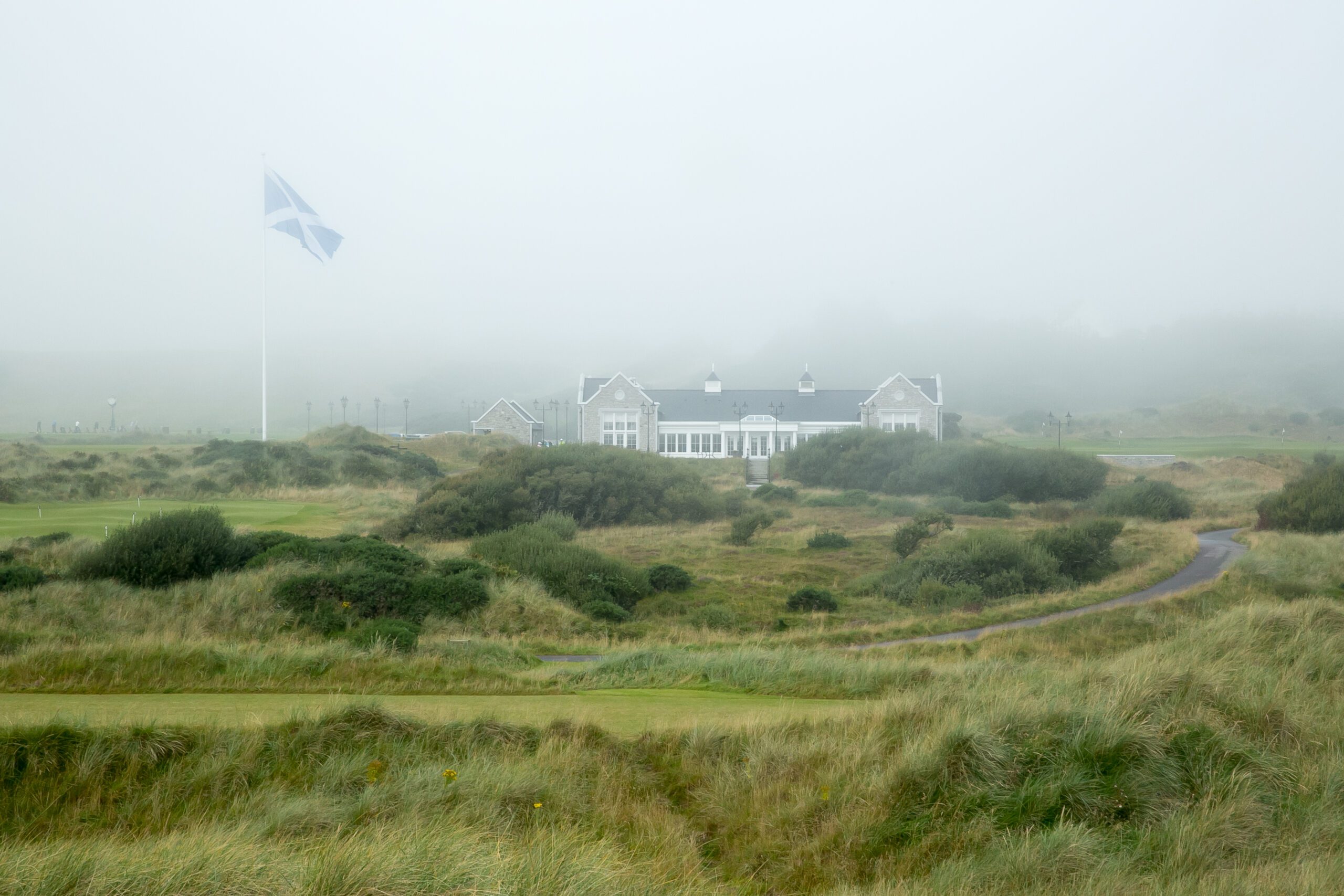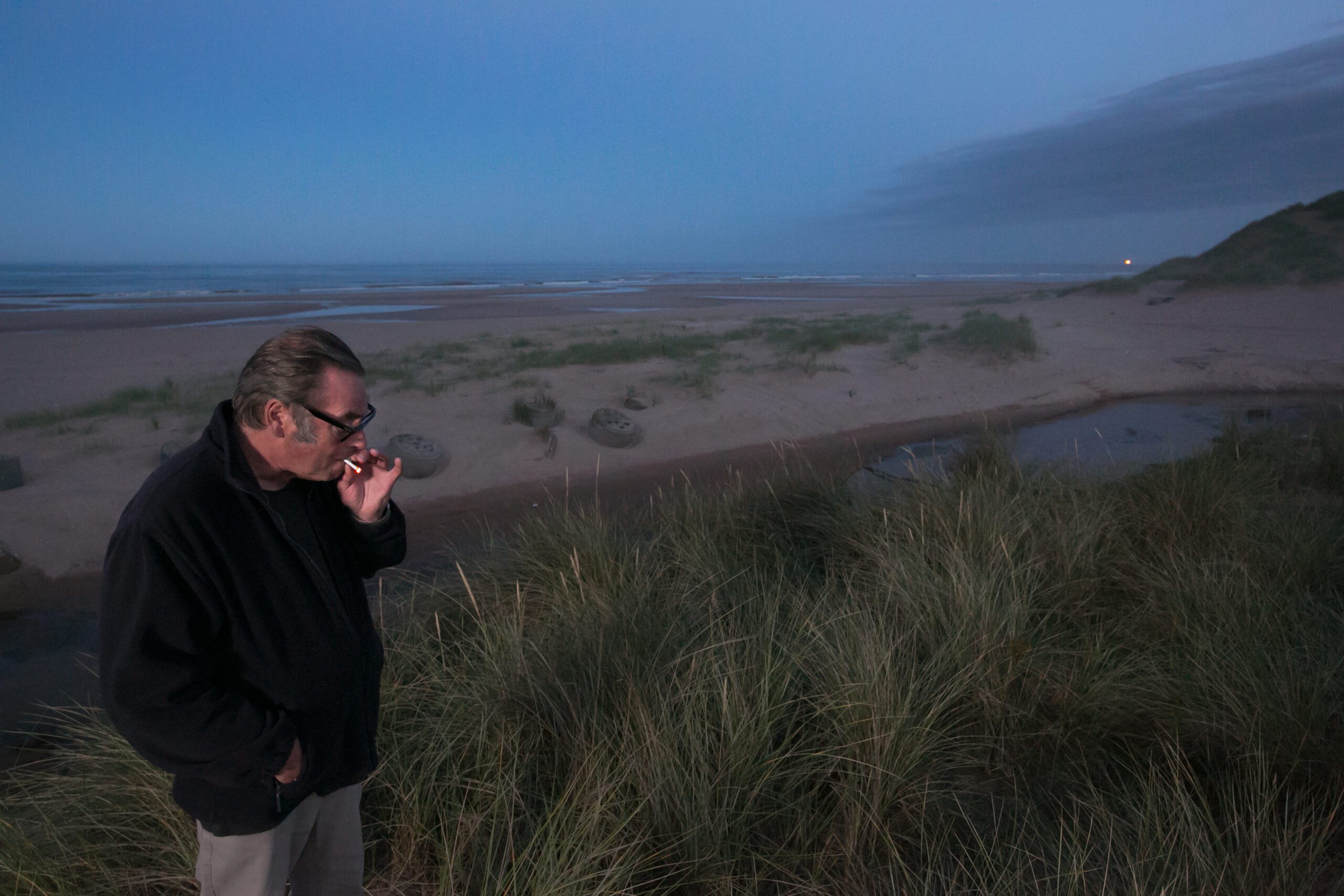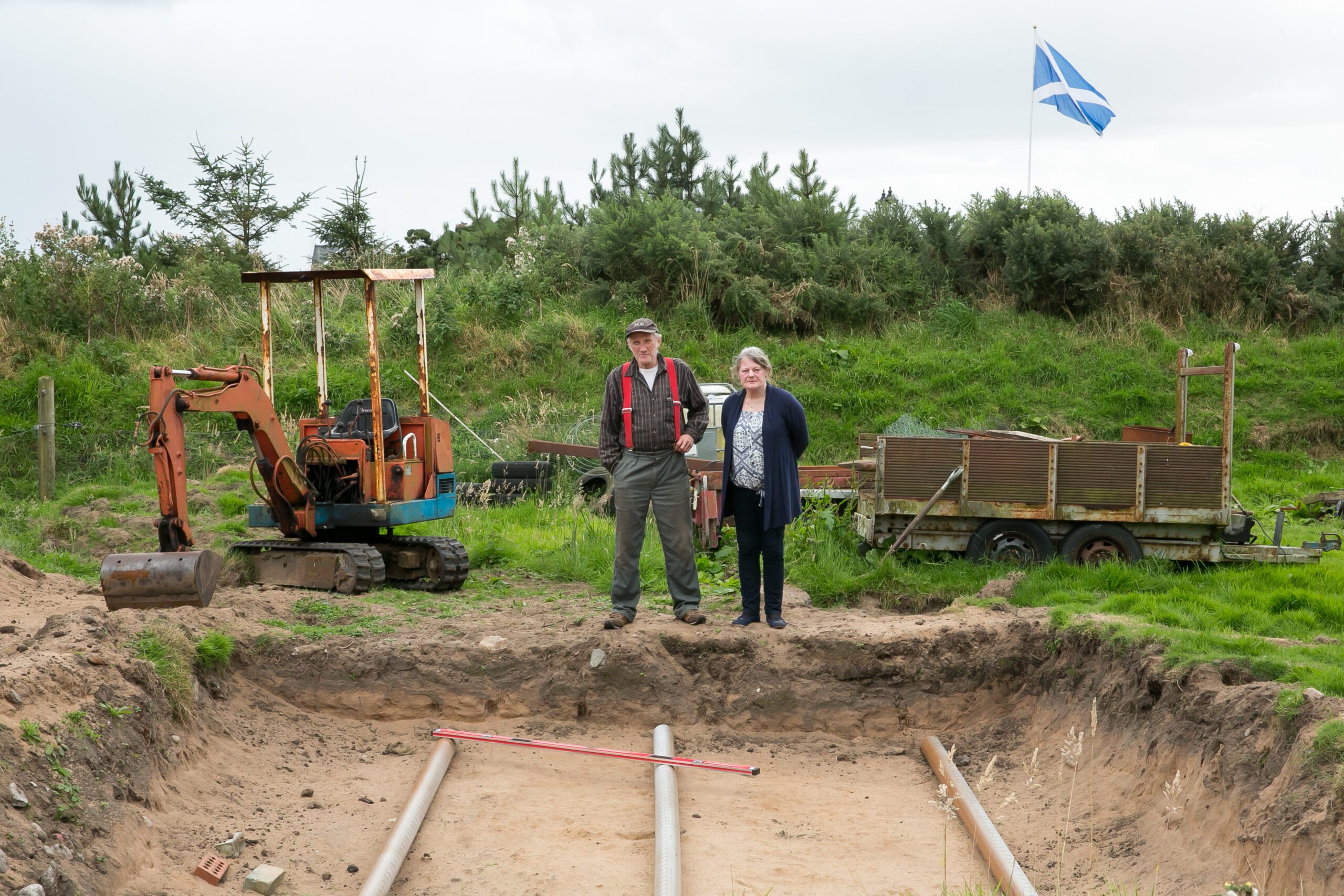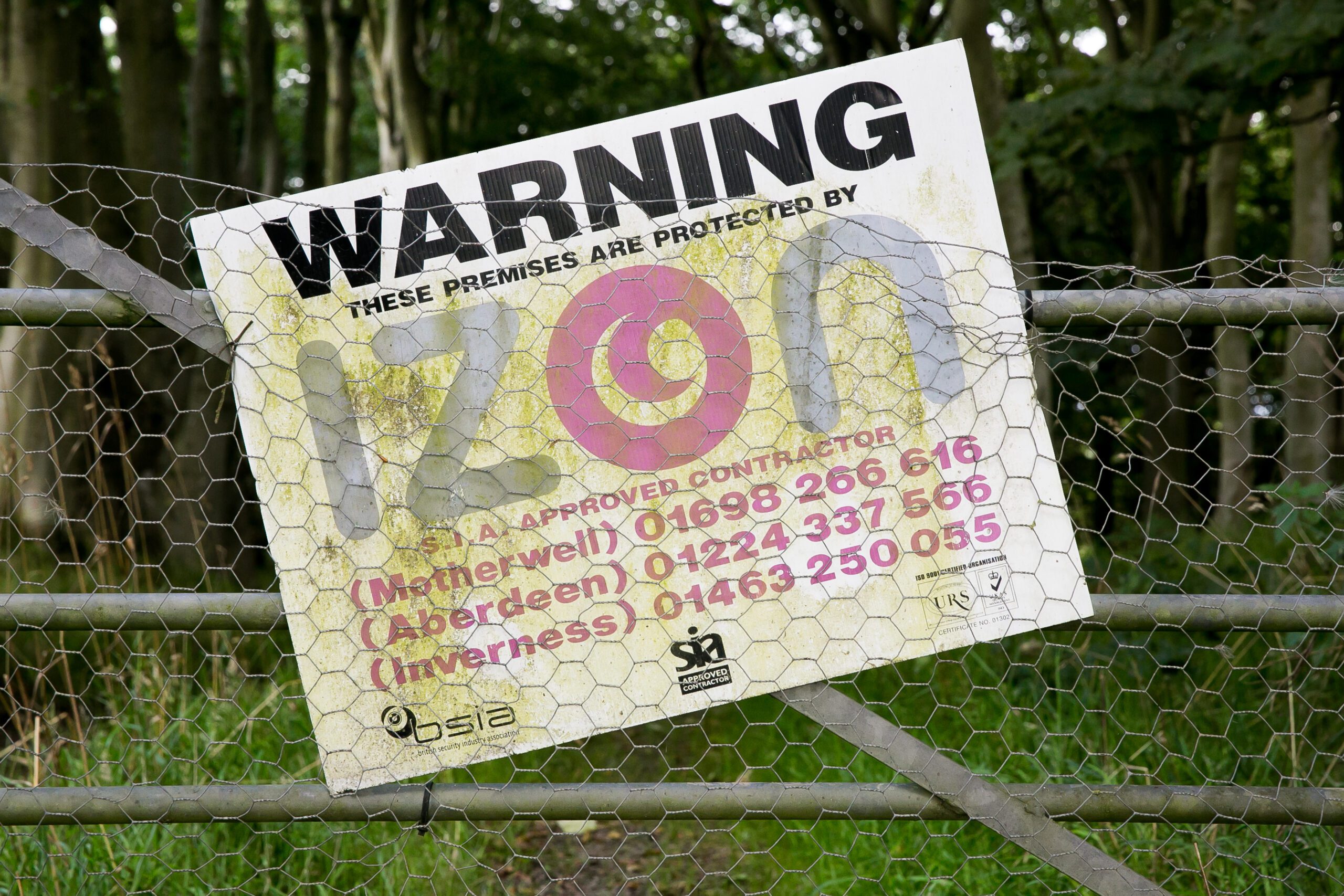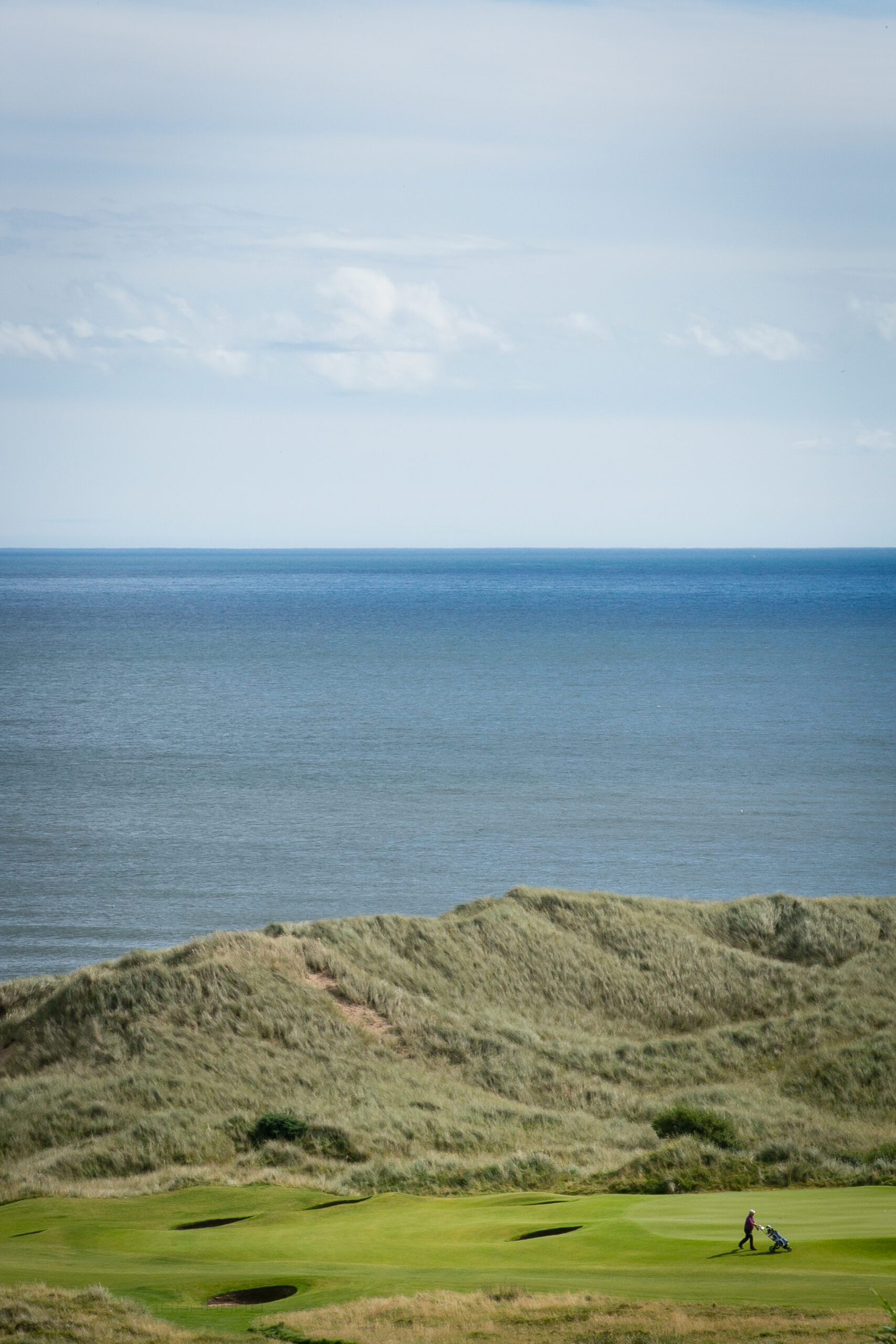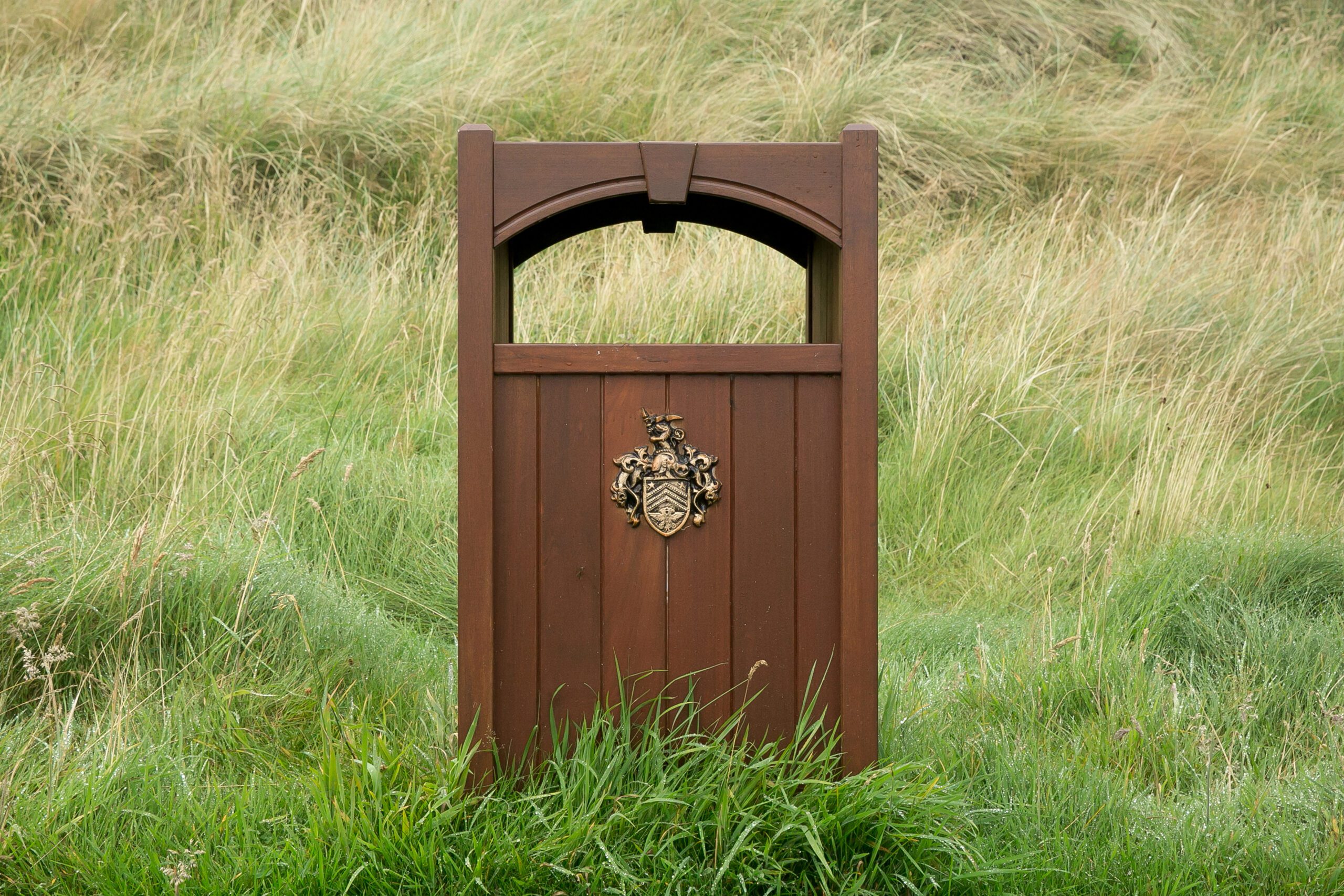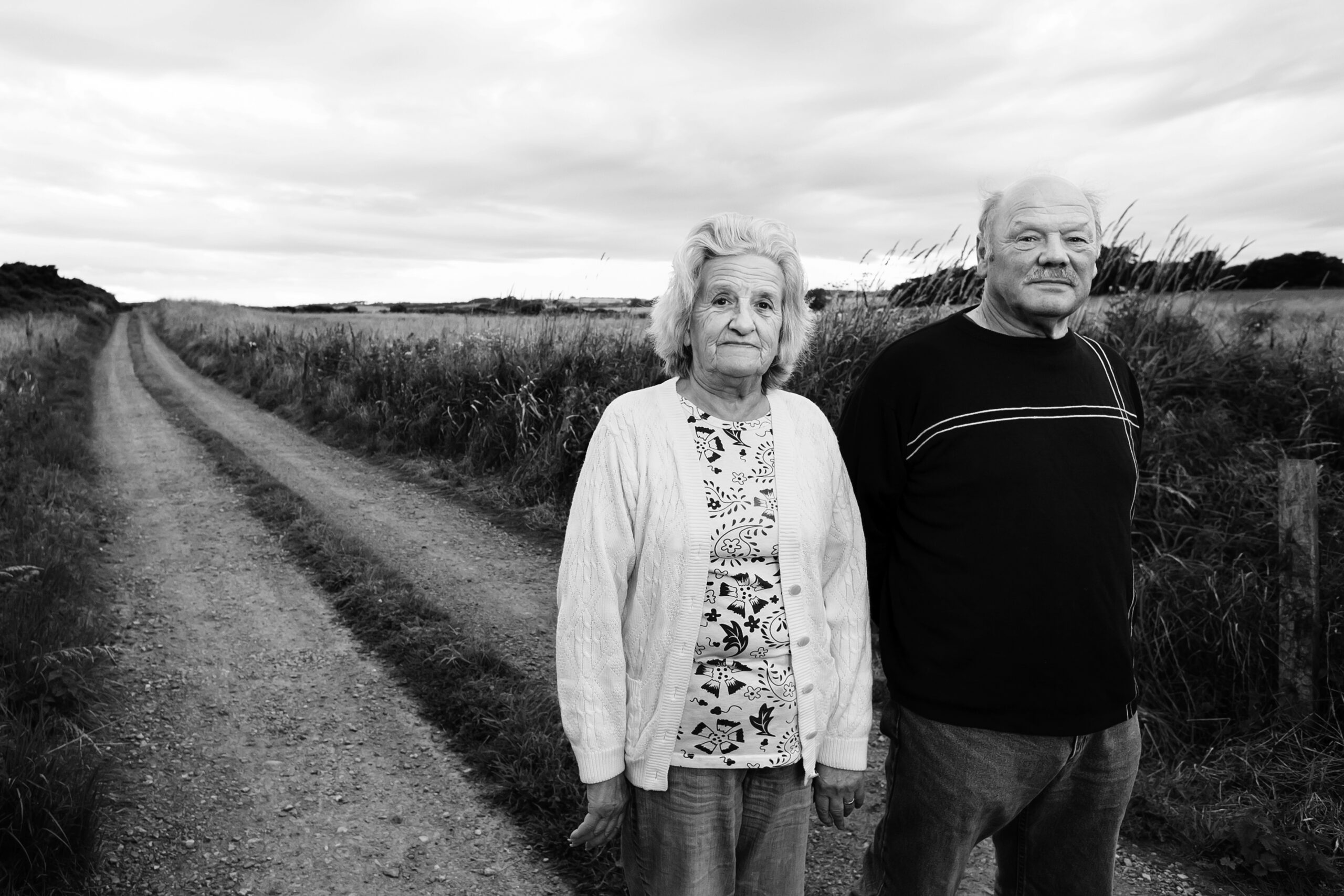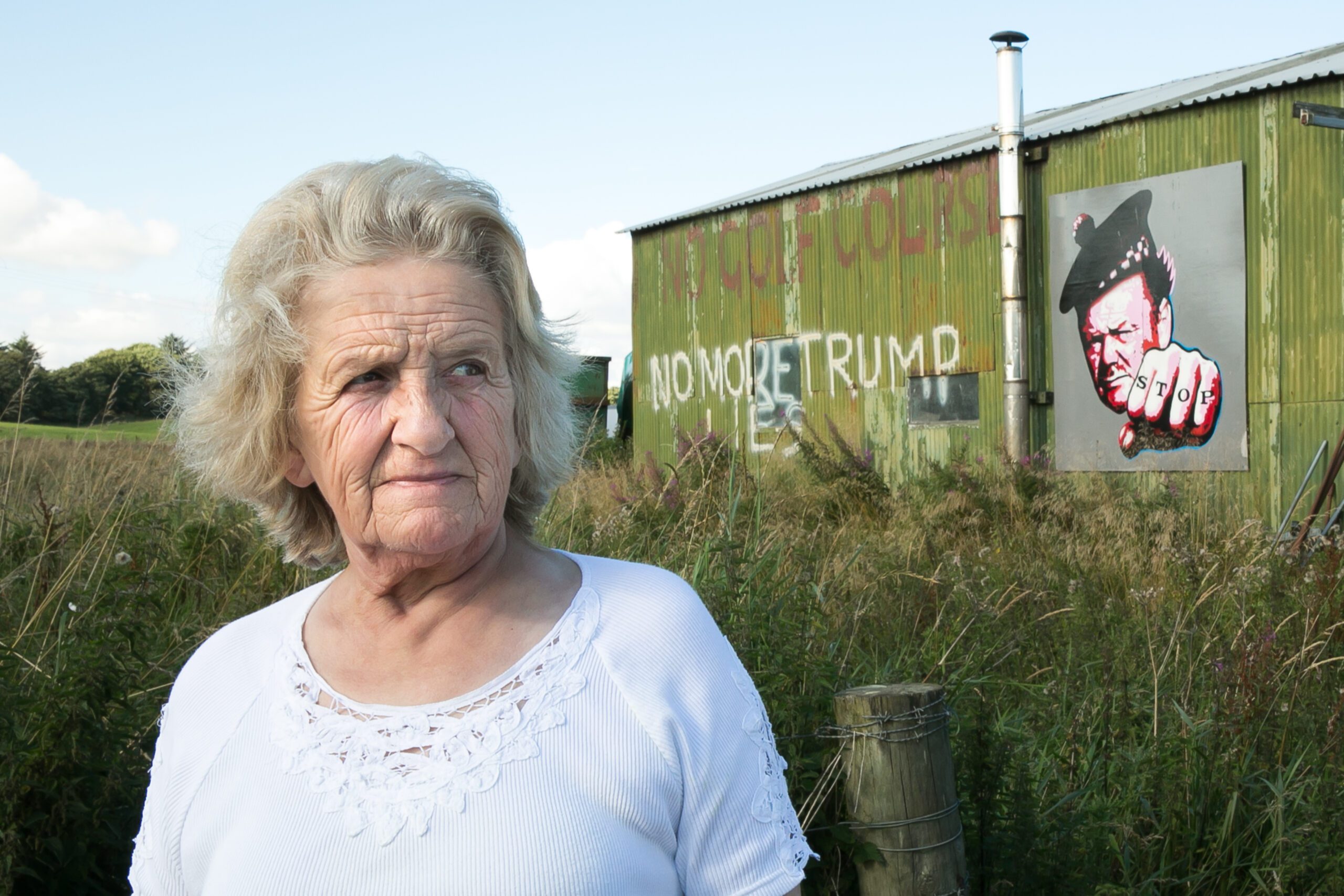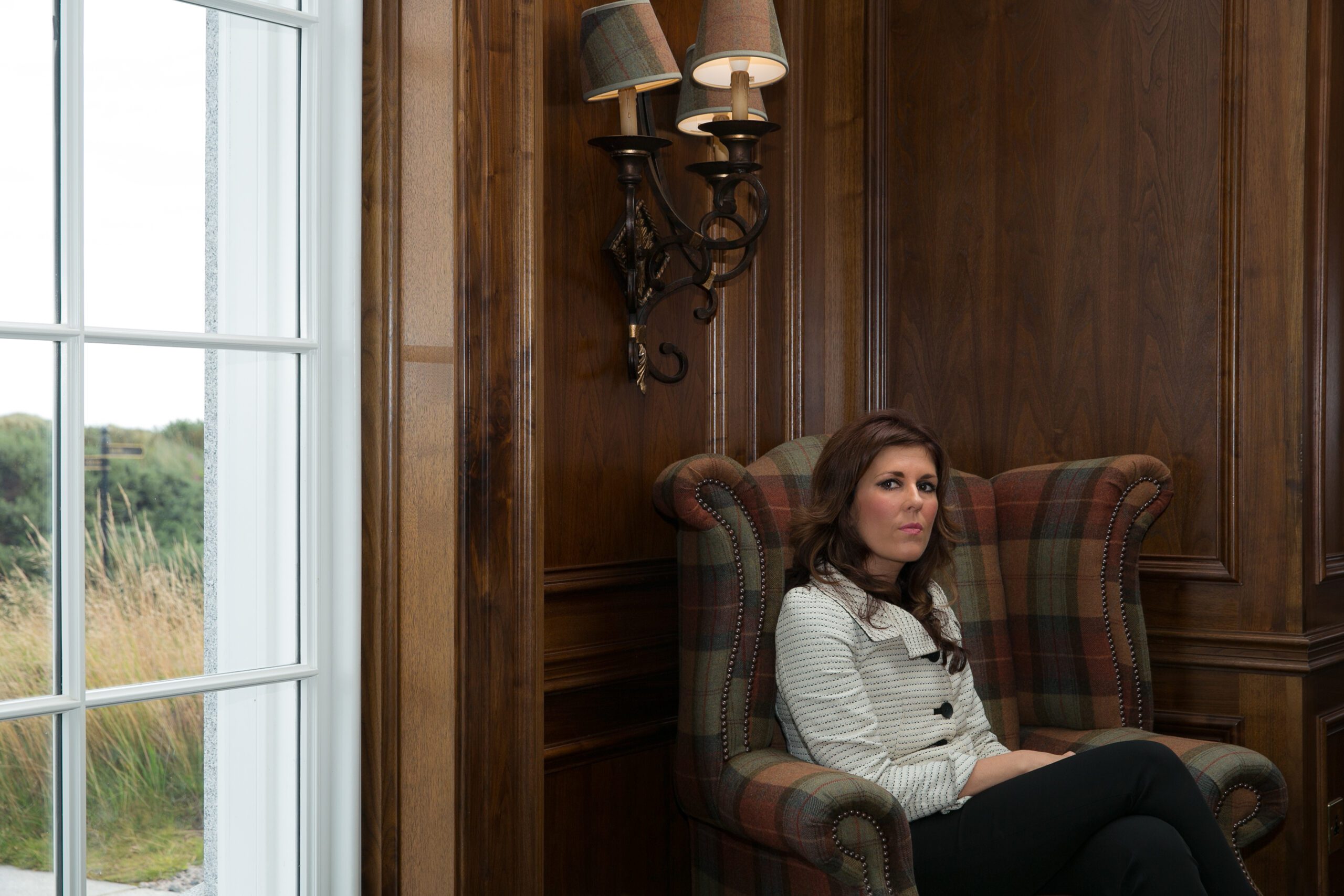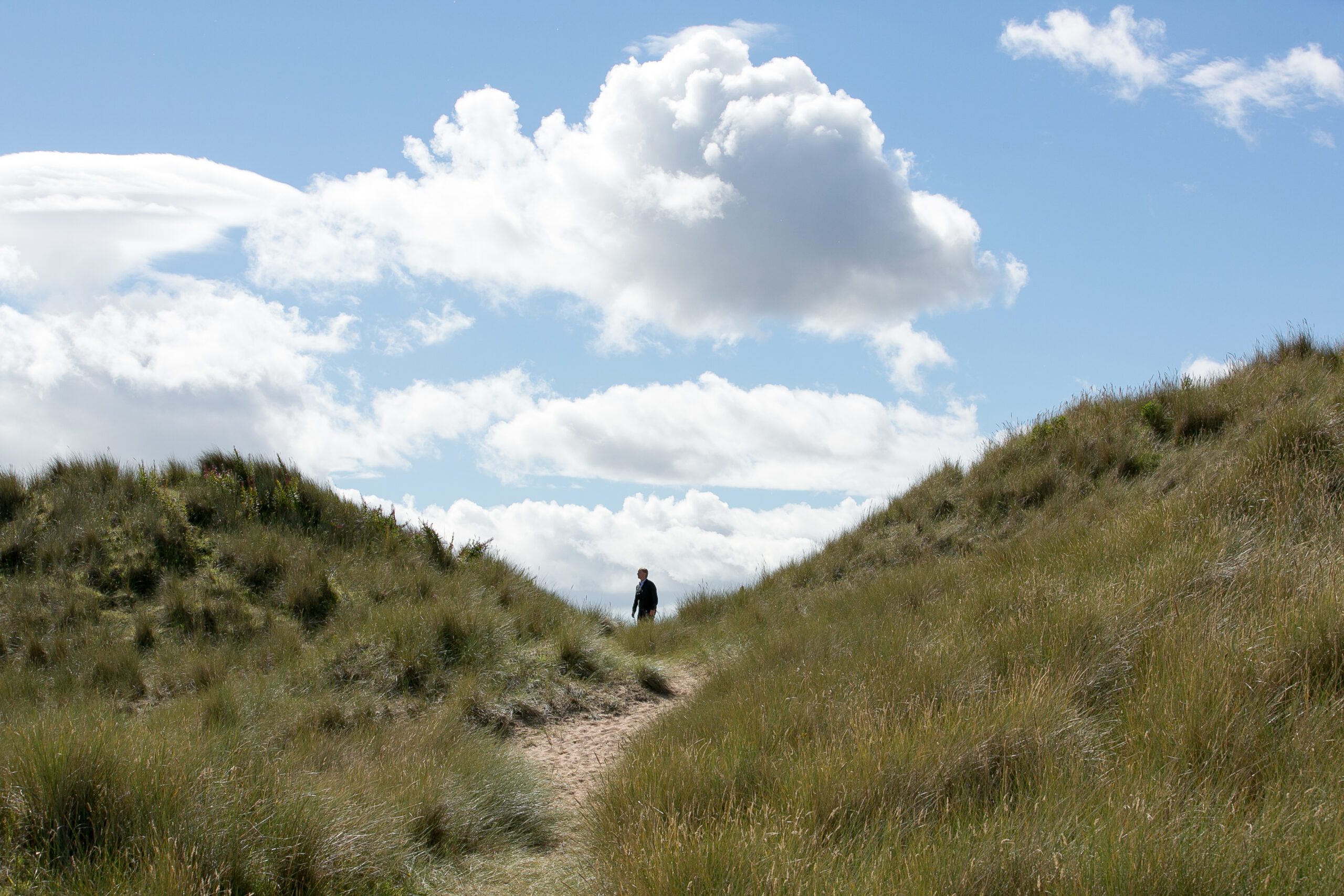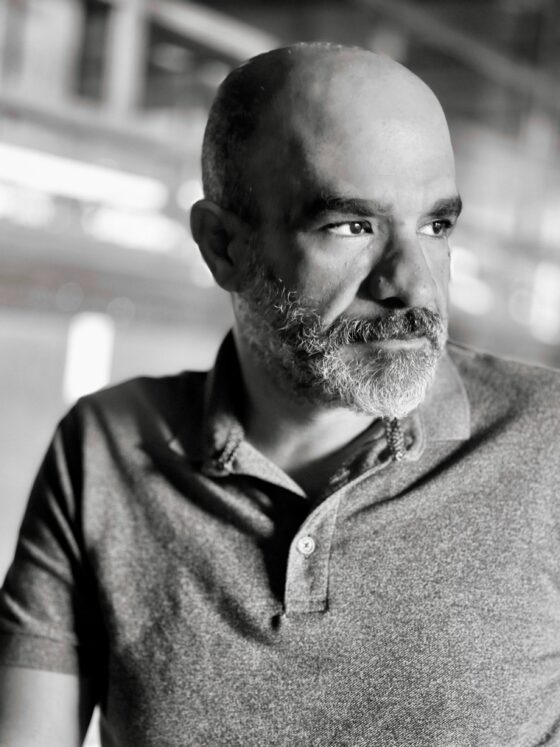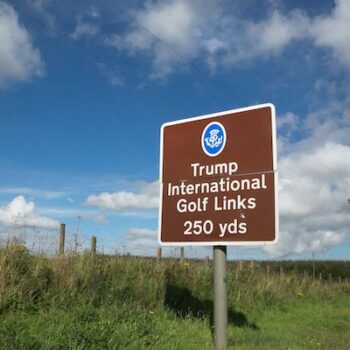
Mickey Foote is pissed. The razor-tongued ex-producer of the Clash is telling me how Trump hoodwinked his country. “The entire fucking government! From the Aberdeenshire Council on up to the Scottish MPs!”
We’re standing on a windswept sand dune overlooking the North Sea. It’s nearly night. The dune joins a series of dunes that stretch along the coastline on for miles, a unique geological formation designated by the Scottish government as a Site of Special Scientific Interest, or SSSI. Home to twenty-two endangered species of wildlife, this land was protected from development until 2009, when Trump received permission to bulldoze it. Building anything on an SSSI is next to impossible, Mickey explains, unless you’re Donald Trump.
“He comes here in 2006 promising he’ll spend $1.5 billion on a golf resort with a luxury hotel and a spa and an equestrian center and tennis courts and holiday houses and it’s all ooooooooooo, big money, 6,000 jobs for Aberdeen, that’s how he got away with it, that’s how he convinced the politicians it was worth destroying a rare and pristine nature preserve, but it was all smoke and mirrors! A decade later we’ve got one golf course, a clubhouse and a measly one hundred jobs. The mirror fell over and the smoke’s cleared.”
Mickey shoots me a wicked grin, withdrawing a pouch of Old Holborn tobacco from the pocket of his black leather jacket. He rolls himself a cigarette and lights it, squinting at the coastline.
Mickey is my eighth interview since I flew to Scotland a few days ago. He lives a mile or so inland, in a house he inherited from his mother. Trump wanted to buy it, but Mickey refused. So did a number of other Aberdeenshire residents I’ve met, among them a shepherd, a quarry foreman, a hairdresser, an oil industry consultant, a retired truck driver, a former part-time gas station cashier, and several farmers. The story they tell is the same. Trump purchased valuable land at rock-bottom, agricultural-rate prices by promising residents he’d never build houses on it. But the golf resort proposal he submitted to the Scottish government included plans for 950 holiday apartments, 36 luxury villas, and 500 houses with price tags ranging from $827,000 to more than $2.1 million.
“That’s his confidence trick,” Mickey says. “Buying cheap, getting the zoning changed, then getting the green light to build a bloody mess o’ houses.”
Trump got the green light on December 16, 2008, when the Scottish Ministers granted planning approval for Trump International Golf Links Scotland. Four months later Trump tried to seize the land of residents who refused to sell it by invoking compulsory purchase orders, Scotland’s version of eminent domain. Trump publicly denied this in 2011: “We have no interest in compulsory purchase and have never applied for it.” But documents obtained by a Freedom of Information Act request tell another story. On March 4, 2009, in a letter marked strictly private and confidential, Trump asked the Aberdeenshire Council to seize eight plots of land on behalf of Trump International Golf Links Scotland through compulsory purchase orders, necessitating the forcible ejection of thirteen residents from their homes.
The haar is rolling in, a thick coastal fog that settles like a blanket over the dunes. Mickey’s cigarette smoke disappears into it. I’m thinking of a Clash song on the album Mickey produced, the one with Joe Strummer hollering:
All the power’s in the hands
Of people rich enough to buy it
Mickey tells me he moved into his mother’s Aberdeenshire house to find some peace after too many years of London punk-rock hard living. Then Trump came along and brought back the mayhem. Mickey fought Trump’s golf resort development for years, serving as a spokesman for Sustainable Aberdeenshire, an environmental group that found good company in opposing the billionaire’s proposal to build on SSSI-protected land. Scottish Natural Heritage, the Scottish government’s environmental agency, also opposed it. So did the Scottish Wildlife Trust, the Royal Society for the Protection of Birds, and the Botanical Society of the British Isles, citing the likelihood of severe irreparable damage to a rare dune habitat. Still, Trump insisted in a press conference that he had “tremendous support from the major environmental groups.”
Mickey’s got a thousand ways to call Trump a liar. Slipperier than a carriage floor is what he says now.
I ask Mickey about the lowball offer he received on his mother’s house. Did Trump send a letter? A lawyer?
“A lawyer. A solicitor, as we say in Scotland. George Sorial, Executive VP and Counsel of the Trump Organization. Georgie walks up to me wearing this luminous suit and says, ‘Hey, Mickey, what would it take to get you outta here? Sell me your house and I’ll toss in a bit o’ candy, I’ll name a hole on the golf course after you.’
Mickey flashes his wicked grin. “So I say to Georgie, ‘What’re you gonna call it? The Asshole?’”
Mickey’s not the only one who’s pissed. Lots of residents of Aberdeenshire are, it turns out. I dedicate a week to meeting them, knocking on doors, hearing their stories. I sit in kitchens, accompany farmers in their daily chores, drink pints at the local pub. One glorious afternoon I run across a muddy pasture with a badass woman shepherd and 500 of her sheep. Shelly’s got a warm smile and a cool way of cutting to the quick. “Trump’s a bully.”
“And a liar,” her husband Raymond cuts in. “His word’s not worth a penny or a pound.”
While the Aberdeenshire Council didn’t eject residents from their homes on Trump’s behalf, it hasn’t rejected the billionaire’s request either. At a planning meeting held in October 2009, the issue was tabled, the council effectively deciding not to decide.
To this day, the threat of forcible eviction looms continuously over the residents’ heads. It’s a precarious way to live, fueling a resentment that has simmered for years, and as I make the rounds in Aberdeenshire I see it spark into rage the moment I mention the name Trump.
*
Susan and John Munro bought their modest, single-story cottage thirty-five years ago. Like many homes here, their cottage faces the North Sea. Once, it commanded a view of the rolling dunes and a lighthouse ten miles down the coastline. “Couldn’t have been a better place to bring up my two boys,” Susan Munro tells me, gazing out her kitchen window. “They had the run o’ the place.”
Now, she can no longer see the lighthouse, the sea, or the dunes. Massive mounds of dirt encircle her house, blocking the view entirely and enshrouding the house in darkness. The mounds have a name: bunds. Bunds are meant to be temporary, a sometimes-necessary feature of a construction site. But they’ve been here for years.
“Trump wants our property,” says Susan. “We won’t sell it to him, so he makes our lives hell.”
Her husband John sits glumly at the kitchen table, fingering a well-worn brown cap with the name of his former employer on it, Northburn Industrial Services. “Oil waste collection,” he explains, “I used to drive the truck. Before that it was offshore drilling. Was a floorman on a drill crew.” I ask what a floorman is, and John quips, “Another name for a redneck.” This brings a twinkle to his weary, sea-blue eyes, then it’s gone, quick as it came. John is retired now. So is Susan, who once worked in sales for the Aberdeen Journal and as a part-time cashier at a local gas station that’s gone out of business.
“Trump’s got no permit for them! No planning permission, I tell ya’! In 2010 they say it’s temporary. Ya’ call six years temporary?”
Susan’s back to the bunds, and it’s easy to see why. Their presence here feels punitive, an effect reinforced by the imposing padlocked fence that Trump’s construction crew erected alongside the bunds, not to mention the abundance of gorse bushes, stinging nettle and thistle that Trump’s landscapers planted atop and around them. The spiny, spiked plants are the horticultural equivalent of barbed wire.
Trump representatives say the Aberdeenshire Council approved the erection of bunds on the Munro property, a claim that can’t be supported by the local government’s documents.
“It’s been rough on me,” Susan murmurs, “all of it.” Recently, her elderly mother passed away. It’s taken months to clear out her mother’s house, Susan tells me, touching what she calls the wee amethyst in the simple necklace she wears. A gift from her mother many years ago.
Susan’s eyes have gone misty, but there’s a pugilist’s set to her jaw now. She’s squinting at the bunds again.
“Trump thinks he can bully us out. I won’t let him, I tell ya’, I won’t.”
Perched on a majestic bluff is a Coast Guard station that David and Moira Milne have painstakingly renovated over twenty years. Their home stands at the highest point of the surrounding 1400 acres Trump bought in 2006, with sweeping views of the North Sea and the coastline. In 2007, a letter on garish, gold-embossed stationary arrived with Trump’s first lowball offer: $175,000 (the asking price of a two-bedroom apartment near the Aberdeen airport, David tells me). In 2009, Trump increased the offer to $200,000 and threw in a lifetime membership to his golf course.
David Milne refused to sell.
Trump changed tactics, and tried unsuccessfully to seize the property via compulsory purchase in 2009.
Trump changed tactics again in 2010, and hired some men to erect a fence around the house and plant a dense stand of trees in the front yard, obscuring the view.
“And Trump has the audacity to demand I pay him for a fence he put up,” David fumes. “He sent me a bill for four thousand dollars and I’m not paying it, never will. And the trees, don’t get me started on the trees.”
David is an oil industry consultant who has devoted a decade to fighting Trump. He’s the author of a self-published book about Trump’s dealings in Aberdeenshire called Blinded by the Bling and a key member of Tripping Up Trump, a local group that mounted a vigorous campaign against the billionaire’s pursuit of compulsory purchase. His grasp of the facts related to the golf course development, including Aberdeenshire Council planning procedures, is encyclopedic. He knows whose land Trump succeeded in purchasing, and for how much, and he’s got the documents to prove it. He’s got a stack of deeds and maps as thick as his wrist.
He shows me the deed for an elderly farmer’s sale of 87 acres to Trump on December 1, 2006 for a price that’s staggeringly below market.
“Now Trump’s desecrated that land. A disgrace.”
It’s a beautiful Sunday afternoon when David shows me the trees. The sun is a bright coin in the sky. A perfect day for golf. But there are few golfers playing on the course, which David says is fairly typical, a view expressed by many Aberdeenshire residents I meet. “The course is losing money,” David says, “a million pounds a year since it opened, anyone can look up the figures on the government’s website, and still Trump claims the course is a massive success.” From this vantage, walking down an incline on the perimeter of David’s property, we can see the fairways, a perfectly manicured expanse of grass dyed an unnatural shade of green. The scrupulous attention the turf grass receives from Trump’s landscapers is not accorded to the stands of Sitka spruce, sycamore, and scotch pine that form an arboreal wall meant to conceal David’s house from golfers teeing up on Trump’s course. The trees are a sorry sight, and do a poor job of concealing anything. This is because they are in various stages of dying. Sycamores that are dead or nearly dead have lost their leaves. Spruce and pine are brown-needled, or bald.
“They’re neglected,” David says, pointing to an old, mustard-colored irrigation hose that’s no longer in use. “The first batch of trees Trump’s landscapers planted died. They had to come here and rip them out and plant a new batch. Now these are dying, too. In a year or so they’ll come here and rip these out, plant a new batch. Another disgrace.”
Later, I track down the elderly farmer who sold the 87-acre plot to Trump for a song, and have my first face-to-face encounter with a self-avowed Trump supporter. Not the farmer—his son. A middle-aged man who sizes me up and decides I’m trouble.
I ask the question I’ve been asking every resident in Aberdeenshire—“If you lived in America, would you vote for Trump?” I don’t mention the deed or the 87 acres.
“Aye, I’d vote for him!” He’s grinning like crazy.
“How much land did your father sell to Trump?”
The guy’s still grinning. He turns his palms up, a gesture of frank disclosure. “It was just a sliver, Miss,” he lies. “Hardly any land at all.”
*
HOW SCOTLAND WILL HELP ME BECOME PRESIDENT.
This is the headline of a column Trump wrote in April for the Press & Journal, a regional daily newspaper Aberdeenshire residents call The P&J or, if they’re in a fouler mood, Trump’s mouthpiece, expressing their belief that the billionaire has a lock on the local media. The paper’s editor, Damian Bates, happens to be the husband of Sarah Malone, Executive Vice President of Trump International Golf Links Scotland, and Aberdeenshire residents cry foul when Bates publishes articles that cast a flattering light on Trump.
In the column, the Republican candidate predicts he’ll win the US presidential race:
When I first arrived on the scene in Aberdeen, the people of Scotland were testing me to see just how serious I was—just like the citizens in the United States have done about my race for the White House. I had to win them over—I had to convince them that I meant business and that I had their best interests in mind.
Well, Scotland has already been won—and so will the United States.
Trump’s insistence that he has “won” Scotland is dubious in the face of much evidence to the contrary, say his Scottish critics. (As one Aberdeenshire resident put it, He’s talkin pish.)
Many believe Trump manipulated the government into granting him permission to build his golf resort. They remember November 29, 2007, when the Aberdeenshire Council rejected Trump’s proposal in an 8-7 vote. Legally speaking, this was the final decree. No golf resort. End of discussion, full stop. At this point, a developer’s only recourse is to file an appeal with the Aberdeenshire Council.
And yet, a week later, the Scottish Ministers nullified the local government’s decision. This was unprecedented, according to members of the Aberdeenshire Council’s infrastructure services committee who had voted down the proposal. By way of explanation, the Scottish Parliament released a statement asserting that the government had “called in” the golf resort’s rejected proposal because it required scrutiny at a national level.
But the explanation rang hollow when it emerged that First Minister Alex Salmond had met with Trump Organization representatives George Sorial and Neil Hobday the day before the call-in at a five-star hotel in Aberdeen, a story first reported by the BBC. Then came the revelation that the Scottish government’s chief planner, Jim McKinnon, had invited Trump employees into his office the same day, and that Finance Secretary John Swinney was a guest at one of Trump’s resorts two days earlier.
The scandal sparked accusations of sleaze.
The controversial proposal was approved on November 3, 2008. Swinney cited the “significant economic and social benefit to be gained from the project” that outweighed environmental concerns.
What benefit? Aberdeenshire residents ask now. The 6,000–7,000 jobs Trump promised he’d create across Scotland, including 1400 local and permanent jobs in Aberdeenshire, have failed to materialize. The current figure is a scant 100, according to a representative I spoke with from Trump International Golf Links Scotland, who went on to concede that at least 50% of these jobs are seasonal, as the golf course is closed in winter. What’s more, Trump awarded the multimillion-dollar contract to build his golf course to SOL Golf Course Construction, an Irish company, with Irish workers, who pay Irish taxes. So much for local investment.
Then there’s the fallout from Trump’s objection to the development of an offshore wind farm that’s expected to generate power for 68,000 homes, which the billionaire complained would ruin the scenic views at his golf resort. Trump took out a bizarre full-page advertisement in the Press & Journal comparing then-Scottish First Minister Alex Salmond’s support of the wind farms to to Salmond’s alleged support of a Libyan terrorist convicted for murdering 259 people on board Pan Am Flight 103, otherwise known as the 1988 Lockerbie bombing. The British Advertising Standards Authority banned the ad, and a very public feud escalated between Trump and Salmond, formerly one of his most ardent and influential supporters. Trump declared he would take his business to Ireland and sue the Scottish government, initiating a protracted, two-year legal battle that reached the UK Supreme Court, which ruled unanimously against the tycoon on December 16, 2015.
“Donald Trump’s behavior in working with local and national governments has been appalling from the start,” Councilor Martin Ford tells me.
A member of the Aberdeenshire Council since 1999 and former chairman of the Infrastructure Services Committee, Councilor Ford cast the deciding vote against Trump’s application to build the golf resort in 2007, and is one of Trump’s most outspoken opponents.
With the meticulous precision of a scientist—he holds a doctorate in botany—Councilor Ford presents the case for Trump as a developer who routinely breaches planning policies and appears to be dodging the stringent conditions of the golf resort development.
It’s when I mention the US presidential election that he delivers his most trenchant criticism. I can’t see Councilor Ford’s face—we’re on the phone—but his voice alone carries force. His enunciation is crisp, and as he reaches each point of emphasis I imagine it flushing with decent, moral outrage.
“The way Donald Trump has conducted himself in Scotland is deplorable. This is a man who makes ridiculous exaggerations. His positions are contradictory and irrational. Things that are demonstrably not true he claims are true; things that are true he categorically denies. He appears utterly unable to tell the difference between truth and fiction. He believes he deserves special treatment, and the Scottish government unfortunately granted him this. He was given adulation in ridiculous amounts. He is a nasty and vindictive bully. He’s not a fit or proper person to hold any kind of public office, let alone the presidency of the United States.”
Councilor Ford pauses to catch his breath.
“For goodness sakes do not elect him. It would be a catastrophe. Not only for the United States but for the world.”
*
Trump supporters are hard to find here, but I ferret out a few.
Two refuse to talk to me. Two invite me into their homes. One leaps into his tractor and drives me off his property.
Billy Blair is a civil engineer and longtime golfer. “Forty years I’ve played,” he says, settling into a leather recliner with a beer, “and Trump’s built the best course I’ve seen in my life.” Behind him is a shelf of golf trophies.
“The way the course is laid out, the way it weaves its way through the dunes, the views from the tees, the position of the greens, it’s just a masterpiece,” Billy rhapsodizes, when I ask why Trump’s course is better than the iconic St. Andrews Links, a championship golf course a two-hour drive away that has hosted the Open twenty-nine times. “Look, I do a lot of work with environmental aspects of building roads and substations. The way Trump’s dealt with environmental issues here is fantastic. There’s more nature here now since he’s done what he’s done.”
“What do you mean,” I venture, “by ‘more nature?’”
“Deer. More than ever in my backyard.” Billy takes a swig, and belches. “Wish Trump could get rid of ‘em.”
The last Trump supporter I meet is mercifully kind. Allister Hardy is an eighty-seven-year-old former dairyman who remembers the time he won Best Milking Herd in 1962 and 1964. He’s got gentle eyes and powerful, sun-spotted hands. He invites me to sit in an old upholstered chair and reminisces about a childhood on the dunes, digging the marron grass, somersaulting down mounds of powdery sand.
I ask Allister what he does for pleasure now. “Ya know what I luv ta do?” he says, slipping deep into his Buchan dialect.
“What?”
“I luv ta dance.”
Trump made an offer on his home, but Allister’s staying put. He’s lived here sixty years, and doesn’t see the wisdom in moving now. Trump’s “honesty” is what Allister admires most. He lives alone; his wife died years ago. “Now Trump’s waitin’ for me ta die,” he says, and lowers his chin.
We’ve hit a solemn note in our conversation, and I can tell Allister doesn’t want to linger on it. When it’s time for me to go, he asks meekly if I’ll join him in a wee waltz. And I do.
*
Sarah Malone, Executive Vice President of Trump International Golf Links Scotland, declines to be interviewed. I’m given the brush-off by one of her handlers, a smug Brit who tells me Sarah is busy with various meetings this week I’m afraid.
I head out instead to visit two farmers, Michael and Sheila Forbes, who roll their eyes at the mention of Ms. Malone. Her name elicits eye-rolls from others I’ve spoken to, too. From their descriptions, I glean that the woman Trump has chosen to oversee PR at his golf resort is beautiful and well-heeled and apparently fond of perfume—the fragrant Sarah, quipped one resident.
“Aye, Sarah, the local quine from Peterhead.” Michael’s exaggerating the Doric dialect to make his point. Quayne. Peeter-heed. A “quine” is a girl, “Peterhead” is a town in Aberdeenshire founded by fishermen. What he means is: Sarah Malone wants street cred. People here note her posh elocution and fancy clothes and resent her for reminding them of her roots. She’s a little like J. Lo—Don’t be fooled by the rocks that I got/ I’m still-I’m still Jenny from the block—if you swap South Bronx for Aberdeenshire and picture her stalking the sand dunes in Chanel, pressuring residents to sell their houses to Trump.
Michael and Sheila Forbes own 23 acres smack in the middle of Trump’s 1400. Trump made four offers. The first was $350,000. The second, $375,000. The third?
“Tore it up,” Michael Forbes says, beaming. “Tore up the fourth, too.”
(Trump representatives say they offered him a six-figure job, which Forbes adamantly denies. They also say Forbes asked for $2 million, which Forbes calls a bloomin lie.)
At fourteen, Forbes left school to learn his trade, continuing the family tradition; his great-grandfather, grandfather, great uncles, uncles, and father were all salmon fishermen. Now, he’s a quarry foreman and former fisherman. Former, because Trump blocked his access to the water.
Furious, he painted NO MORE TRUMP LIES on the side of his barn. Trump told reporters that Forbes “lives like a pig.”
Michael’s telling me all this while repairing the starter from a gray tractor he calls a Fergie. The tractor was built in 1948, and it’s a beauty. There are several about, and there’s farm equipment, too, not to mention thirty hens and a very busy rooster. When Trump told millions of television viewers that the place was “a slum,” the billionaire apparently failed to understand that this is what a working farm looks like. The British filmmaker Anthony Baxter directed a spotlight on their spat in his excellent documentary You’ve Been Trumped, and an avalanche of newspaper articles followed, bringing letters from around the world into Michael and Sheila Forbes’s mailbox.
Later, over milky tea in the living room, I ask if I can read the letters, and Sheila Forbes sets down her cup and disappears into a back room. She returns with three big bags. Some letters are postmarked with address like:
Mr. Michael Forbes
David Against Goliath In The Trump Case
Balmedie, Aberdeenshire
And:
Mr. Mike Forbes
Farmer
Who Lives Near Aberdeen
Who Opposes Against
New Golf Course And Hotel
Near Aberdeen
And:
Mr Michael Forbes
Farmer?
Balmerdie?
Balmedie?
Aberdeenshire
Scotland
Astonishingly, the letters reached their destination, a testament to the tenacity of more than one sympathetic postal worker. I spend hours going through them. My spirits were raised when I read in the Times of your refusal to give in to Donald Trump and his henchmen, says one. Keep fighting Michael and Sheila! says another. On each letter I see Sheila’s carefully penciled checkmark; she has answered them all.
The next morning I’m sitting in the clubhouse across from Sarah Malone, who’s showing me the Trump Coat of Arms in a folder of publicity materials. Her handler left a message on my cell, cheerily informing me that Sarah does happen to have time today, and wouldn’t I like to stop by and have a chat before I go?
The Trump Coat of Arms is emblazoned with the motto Numquam concedere.
“It means ‘never give up,’ which of course is Mr. Trump’s motto,” Sarah says. “You’ll see we’ve incorporated his family coat of arms into the décor.” She sweeps a hand around a room sumptuously furnished in walnut and leather.
The Trump Coat of Arms isn’t confined to the clubhouse décor. The black-and-gold branding is everywhere. Every tee on the course is marked with it. It’s on walls, menus, brochures, even trashcans.
As Executive Vice President of Trump International Golf Links Scotland, Sarah Malone plays the unenviable role of overseeing the PR of a much-maligned enterprise. Last month, the Information Commissioner’s Office discovered that the golf course had breached data protection laws by failing to register its extensive video surveillance system, a criminal offense. Her office released a statement that called it a “clerical oversight.”
“I feel a tremendous injustice at the accusations of harassment and bullying,” Sarah tells me, laying a lovely, well-groomed hand on her chest. “I have worked very hard for Mr. Trump. Those accusations are baseless and have added to the scrutiny.” As she goes on to describe the “one or two people” who don’t support Trump in Aberdeenshire and have made her job difficult, I wonder whether she knows she’s misrepresenting the truth. Or has the woman who spent her childhood in Peterhead grown out of touch?
“These people say that Trump has cut off their access to the land and the sea, but that’s not true. In fact, it was less accessible when I was a girl. Trump has increased people’s access.”
I’m mildly shocked by this statement. Scots have a long-cherished “right to roam” that legally entitles them to walk along the beach and up the dunes, and everyone I’ve talked to—and I mean everyone—has told me they don’t have the freedom to roam anymore. There are multiple gates with padlocks where there used to be open roads. It’s a matter of record that Michael Forbes can no longer fish because Trump bulldozed the road he used to haul his boat to the water. Residents who rode their horses on the dunes can do so no longer. Many residents report being followed or harassed by Trump’s security guards.
“Trump has taken a neglected part of Aberdeenshire and done something with it,” Sarah persists. “He has stabilized the dunes. He has created something great out of nothing.”
A stretch of mobile sand dunes designated as SSSI land—the highest level of conservation protection the UK can grant—is not nothing.
I remember what a scientist said to me my first day in Aberdeenshire. “Here’s what Trump thinks: disorder is bad; order is good. Trump thinks he’s got to subdue the land. It’s Biblical.”
Dr. Ian Francis was one of many scientists who opposed Trump’s development. Building a golf course on mobile sand dunes requires covering the sand with a latex spray, planting seeded marron grass through it, and fertilizing the hell out of it. Doing this disrupts the natural habitat of animals and plant life here, including dozens of endangered species.
“One of the most beautiful aspects of this land,” Dr. Francis told me, “is that it is unpredictable, dynamic, changes from time to time, has all these unplanned elements—wet bits and dry bits and mobile bits and stable bits, and a big storm comes along and everything changes again. What has Trump done? He’s destroyed it all.”
I’m walking across Trump’s dyed rye grass fairways to the 18th hole. It’s my last day here. In an hour, I’ll drive to Edinburgh and take a plane home. I’m thinking of the residents of Aberdeenshire. They’ve fought Trump for a decade, and I wonder how long they can continue the fight.
Ten years ago, Trump arrived in Aberdeenshire and announced he would honor his Scottish mother Mary by building “the greatest golf course in the world.” Trump painted a gilded picture of a luxury golf resort, then posed for photographs while a kilted bagpiper-for-hire played “Scotland the Brave.” Mary MacLeod is from the remote Isle of Lewis, where her father eked out a living as a fisherman and crofter. The staged event in Aberdeenshire was 200 miles away from Trump’s ancestral homeland, but it may as well have been a million.
I reach the 18th hole. The view is spectacular, golfers tell me. Standing atop the hundred-foot dune, you can see a magnificent expanse of the North Sea shoreline, from the Aberdeen lighthouse to Cruden Bay. But the haar has rolled in again, and I can’t see much farther than my feet. Turning back, I trip over a hole that’s big enough for an animal to burrow into. I see another, and another, and another—dozens of holes fouling the fairway. Rabbits. Trump gassed thousands of them when he built the course, but he can’t get rid of them.
***
Some names have been changed. All photographs © Beowulf Sheehan.

